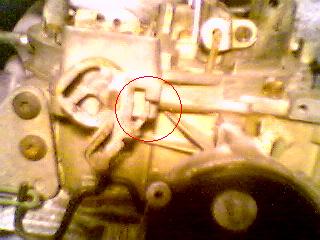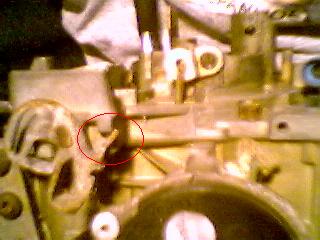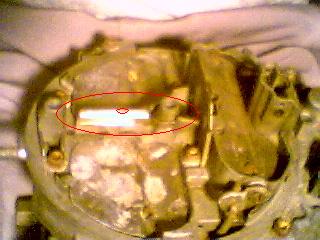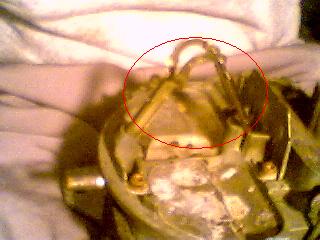|
|
 Getting the secondaries to open fully is a 5 minute job only tools needed is a pair of needle nose plyers. If you have a backed up exhaust
or never replace your air filter then this modification will not be noticable on the road because you have other restrictions
to worry about first but if you have a decent flowing exhaust and clean air filter with a good flowing breather box than you
could use better flowing secondaries on your electronic Q Jet carburetor for more top end power most noticable above
4000 RPMs. Follow the pictures with instructions below as I try my best to explain this most simple modification Getting the secondaries to open fully is a 5 minute job only tools needed is a pair of needle nose plyers. If you have a backed up exhaust
or never replace your air filter then this modification will not be noticable on the road because you have other restrictions
to worry about first but if you have a decent flowing exhaust and clean air filter with a good flowing breather box than you
could use better flowing secondaries on your electronic Q Jet carburetor for more top end power most noticable above
4000 RPMs. Follow the pictures with instructions below as I try my best to explain this most simple modification  . . | |

The picture above shows how far the stock secondaries air valve opens before
modification.

The above picture shows how far the secondaries air valve should
open after this modification. The front side of the secondary air valve will open to a full vertical angle when done.

Above picture is the passinger side of the carb, if you follow the secondary
air valve shaft to this side you will see the area I have circled, This is with the air valve in the closed position.
This area is what controls how for the secondaries are allowed to fully open by using the "stop" circled in the picture.

Above picture is with the air valve fully open notice the shafts end is rested
on its "stop" circled in picture.

Above picture was taken after the "stop" was modified to allow the air
valve to open further than stock, notice the "stop" was bent over to the right so that the air valve's shaft has to rotate
further before the "stop" makes contact with the carbs body. I used needle nose plyers to bend it just to the right, use the
picture as a guide of how far you should bend it, remember the front side of the air valves flap should open to a full vertical
angle when you are finished. I have read that some people like to grind the "stop" shorter to acheive the same results but
grinding leaves you stuck with it that way and is not reversable, if you just bend it like I explained and you end up not
likeing the result then all you got to do is bend it back and all will be back to normal! Simple as that  . Good Luck!!! . Good Luck!!!
 Now you got more intake you could take advantage of more fuel
in there as well. You can go and invest in some richer secondary needles and hangers or you can
modify the ones you have now. Now you got more intake you could take advantage of more fuel
in there as well. You can go and invest in some richer secondary needles and hangers or you can
modify the ones you have now.

This is where the secondary needle hanger sits, it is held in with on screw.

After removing the screw lift the hanger slowly, the needles are attached
to the hanger and will be lifted out with the hanger.

This is the needle and hanger, if you look at the hanger you will see a letter
stamped on it, that is so you can tell how rich the hanger is. The lower in the alphabet the hangers letter is the richer
the hanger so a hanger labled "K" will be richer than a "S". If you grab a hand full of hangers from the junk yard at different
letter code then you can fine tune the secondaries needle hangers by swaping for leaner or richer ones. Note: the hangers
have the most effect on the secondaries fuel ratio during the first 60 feet of the launch, after that the secondaries
needles have more of a effect on the fuel ratio.

If you cant find some richer needles at the junk yard and dont want to pay
full price for new ones just for "trial and error" than you can take some spare stock 307 secondary needles and smoothly grind
the needle point a little sharper but dont go crazy, a little does alot. Gring only the last 10mm's of the needle. If you
look at the picture above the needle on the right is stock and the needle on the left was grinded a little thinner for
a richer mixture, make sure both needles are equally grinded. it is very important that they stay the same lenth as stock,
if you shorten the needle it can get hung up Contact Me! If you have any questions!
|

